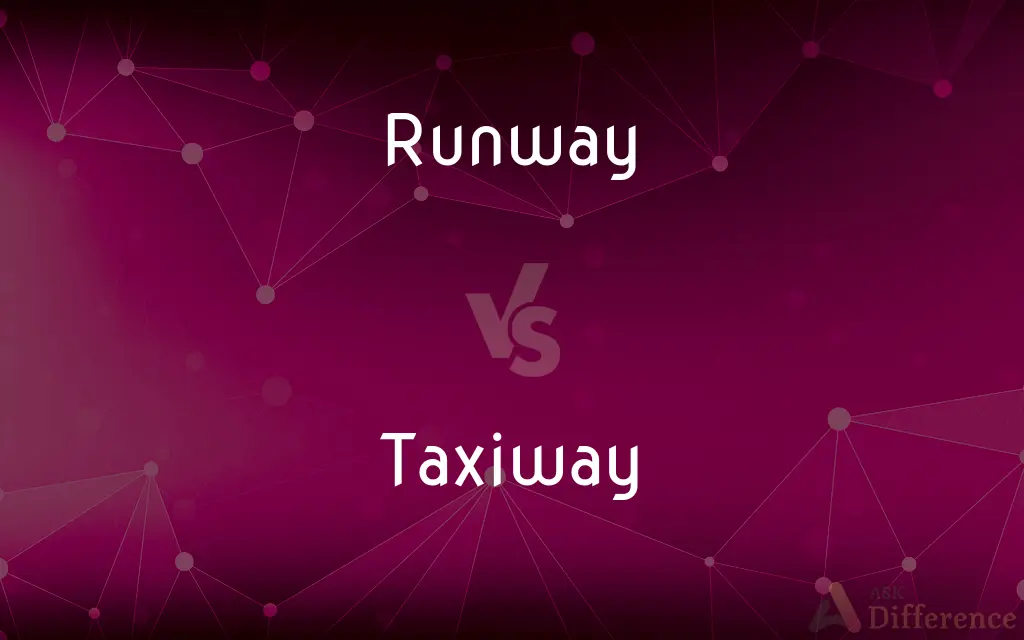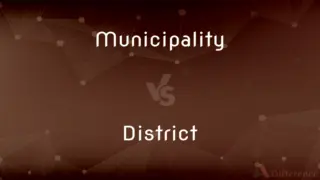Runway vs. Taxiway — What's the Difference?
Edited by Tayyaba Rehman — By Urooj Arif — Updated on April 16, 2024
Runways are designated for aircraft takeoffs and landings, featuring precise orientation markers; taxiways, however, are paths connecting runways and ramps, marked with blue lights.

Difference Between Runway and Taxiway
Table of Contents
ADVERTISEMENT
Key Differences
Runways are critical components of an airport, specifically designed for the landing and takeoff of aircraft. They are carefully oriented to account for wind conditions and are marked with numbers corresponding to their magnetic azimuth. Whereas taxiways serve as the roadways that pilots use to navigate from one part of the airport to another, including runways, aprons, and gates, and are typically marked with blue edge lights to guide nighttime movement.
Runways are constructed to withstand the intense impact and weight of aircraft during landing and takeoff cycles, featuring strong pavement and often longer and wider dimensions. On the other hand, taxiways are built to support the weight of airplanes at lower speeds and loads, designed narrower and with less robust infrastructure compared to runways.
Runway surfaces often include additional features such as touchdown zones and shoulder areas, which are essential for safety during aircraft operations. In contrast, taxiways lack these features but include holding positions that ensure aircraft do not enter runways inadvertently.
Runways have strict clearance and exclusion zones to prevent obstacles and ensure safety during flight operations. Taxiways, while also regulated, focus more on ground movement and thus have different clearance standards to accommodate safe taxiing rather than takeoff and landing.
Runways are equipped with various navigational aids and lighting systems, like PAPI (Precision Approach Path Indicators), to assist in safe landings and takeoffs under different visibility conditions. Taxiways utilize a different set of lighting, including centerline lights and clearance bar lights, which are crucial for safe ground operations during low visibility conditions.
ADVERTISEMENT
Comparison Chart
Purpose
For aircraft takeoffs and landings
For connecting runways, ramps, and gates
Markings
Numbers indicating magnetic azimuth
Blue edge lights
Structural Strength
Built to handle high impact and weight
Supports lower speeds and loads
Additional Features
Touchdown zones, shoulder areas
Holding positions, no touchdown zones
Lighting and Aids
PAPI, runway lights
Centerline lights, clearance bar lights
Compare with Definitions
Runway
Specifically constructed to accommodate the entire flight operation cycle.
The runway was recently repaved to handle heavier aircraft.
Taxiway
Does not include touchdown zones or similar features.
Taxiways terminate at hold lines to prevent accidental runway entry.
Runway
Equipped with navigational and safety aids.
The runway's PAPI lights help pilots maintain the correct approach angle.
Taxiway
A path defined at an airport for aircraft to taxi between runways and gates.
The pilot taxied the plane to the gate using the designated taxiway.
Runway
A strip of land at an airport designated for airplanes to land and take off.
The aircraft lined up on the runway for an early morning takeoff.
Taxiway
Marked distinctly from runways for clarity and safety.
Taxiways are outlined with blue lights for easy identification at night.
Runway
Often oriented based on prevailing wind directions.
Runway 09/27 aligns east-west to match the typical wind patterns.
Taxiway
Includes specific ground navigation aids.
Taxiway signs assist pilots in navigating the complex airport layout.
Runway
Subject to strict regulatory standards for safety.
Regular inspections ensure the runway remains clear of debris and damage.
Taxiway
Supports the positioning and movement of aircraft at lower speeds.
The taxiway system was upgraded to enhance flow and reduce delays.
Runway
According to the International Civil Aviation Organization (ICAO), a runway is a "defined rectangular area on a land aerodrome prepared for the landing and takeoff of aircraft". Runways may be a man-made surface (often asphalt, concrete, or a mixture of both) or a natural surface (grass, dirt, gravel, ice, sand or salt).
Taxiway
A taxiway is a path for aircraft at an airport connecting runways with aprons, hangars, terminals and other facilities. They mostly have a hard surface such as asphalt or concrete, although smaller general aviation airports sometimes use gravel or grass.
Runway
A strip of level, usually paved ground on which aircraft take off and land.
Taxiway
A usually paved strip at an airport for use by aircraft in taxiing to and from a runway.
Runway
A path, channel, or track over which something runs.
Taxiway
(aviation) A road or path within an airport designated for the taxiing of aircraft connecting the runways with ramps, hangars, terminals and other facilities.
Runway
The channel of a stream.
Taxiway
A paved surface in the form of a strip; used by planes taxiing to or from the runway at an airport
Runway
A chute down which logs are skidded.
Runway
A narrow track in a bowling lane on which balls are returned after they are bowled.
Runway
A smooth ramp for wheeled vehicles.
Runway
A narrow walkway extending from a stage into an auditorium.
Runway
A defined, narrow section of land or an artificial structure used for access.
Runway
The usual path taken by deer or other wild animals, such as from a forest to a water source.
Runway
A narrow walkway (often on a platform) extending from a stage on which people walk, especially one used by models during fashion shows.
Runway
(athletics) In javelin, long jump, and similar events: a short track along which athletes can accelerate themselves for their jumps or throws.
Runway
(aviation) A section of land, usually paved, for airplanes to land on or take off from.
Runway
Hence, the number of months that a startup company can operate by using up its cash reserves.
Runway
A stream bed.
Runway
The channel of a stream.
Runway
The beaten path made by deer or other animals in passing to and from their feeding grounds.
Runway
A narrow platform extending from the stage into the audience in a theater or nightclub etc.
Runway
A strip of level paved surface where planes can take off and land
Common Curiosities
How do lighting systems differ between runways and taxiways?
Runways use PAPI and other navigational aids, while taxiways use centerline and clearance bar lights.
What is the primary purpose of a runway?
To allow aircraft to land and take off safely.
How are runways and taxiways marked differently?
Runways are marked with numbers based on their magnetic orientation, while taxiways have blue edge lights.
What safety features are unique to runways?
Runways include touchdown zones and shoulder areas for added safety.
What is a runway threshold?
The beginning of the runway available for landing.
What is the significance of runway orientation?
It is oriented to align with prevailing wind directions for safer operations.
How often are runways inspected?
Regularly, to ensure they meet safety and operational standards.
What role do taxiway hold positions play?
They prevent aircraft from inadvertently entering runways.
Can an aircraft take off from a taxiway?
No, taxiways are not designed for takeoff or landing; they are strictly for taxiing.
Can a taxiway ever be used in an emergency for landing?
Only in extreme emergencies, as taxiways are not designed for safe landings.
Are there international standards for runway and taxiway design?
Yes, both follow specific international standards for safety and efficiency.
What happens if a runway is out of service?
Operations are shifted to another runway or delayed until it can be safely used again.
Are runways always straight?
Yes, runways are straight to facilitate safe takeoff and landing.
Can taxiways handle the same weight as runways?
No, taxiways are designed for lower weights and speeds.
How do pilots identify the correct taxiway?
Through signage and lighting specific to taxiways.
Share Your Discovery

Previous Comparison
Nirvana vs. Heaven
Next Comparison
Municipality vs. DistrictAuthor Spotlight
Written by
Urooj ArifUrooj is a skilled content writer at Ask Difference, known for her exceptional ability to simplify complex topics into engaging and informative content. With a passion for research and a flair for clear, concise writing, she consistently delivers articles that resonate with our diverse audience.
Edited by
Tayyaba RehmanTayyaba Rehman is a distinguished writer, currently serving as a primary contributor to askdifference.com. As a researcher in semantics and etymology, Tayyaba's passion for the complexity of languages and their distinctions has found a perfect home on the platform. Tayyaba delves into the intricacies of language, distinguishing between commonly confused words and phrases, thereby providing clarity for readers worldwide.
















































